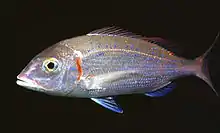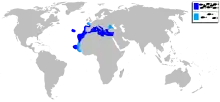Common pandora
The common pandora (Pagellus erythrinus) is a fish of the sea bream family, Sparidae. It is a popular food fish in Mediterranean countries, with delicate white flesh.
| Common pandora | |
|---|---|
 | |
| Scientific classification | |
| Kingdom: | |
| Phylum: | |
| Class: | |
| Order: | |
| Family: | |
| Genus: | |
| Species: | P. erythrinus |
| Binomial name | |
| Pagellus erythrinus | |
 | |
| Distribution of Pagellus erythrinus | |
It has a slim, oval fusiform body, with a smallish mouth and scales covering its face. The eyes are smaller than those of Pagellus bogaraveo and Pagellus acarne. It is silver in colour with a pink tinge, particularly on its back. A typical specimen measures 10–30 cm, but it can reach as much as 50 cm in length.
The common pandora is a hermaphrodite, spending the first two years of its life as a female, and the third year as a male. It is omnivorous, but mainly feeds on smaller fish and benthic invertebrates. As most fishes, the common pandora harbours a variety of parasites. Philometra filiformis is a parasite nematode of the ovary of this fish.[2]
Distribution
The fish is found along the eastern shores Atlantic Ocean, from Scandinavia to Cape Verde, as well as the Mediterranean and the North Sea. In terms of genetic diversity, there appears to be a high level of connectivity from the Atlantic through the Mediterranean.[3]
References
- NatureServe (2013). "Pagellus erythrinus". IUCN Red List of Threatened Species. 2013. Retrieved 15 December 2014.CS1 maint: ref=harv (link)
- Moravec, František; Ghanmi, Nessrine; Chaabane, Amira; Gargouri, Lamia; Justine, Jean-Lou (2017). "Redescription of Philometra filiformis (Stossich, 1896) (Nematoda: Philometridae), a gonad-infecting parasite of the common pandora Pagellus erythrinus (Linnaeus) (Sparidae) in the Mediterranean Sea, including new taxonomic features revealed by SEM". Systematic Parasitology. 94 (9): 979–987. doi:10.1007/s11230-017-9758-9. PMID 29027088.
- Angiulli, Elisa; et al. (2016). "Phylogeography of the common pandora Pagellus erythrinus in the central Mediterranean Sea: sympatric mitochondrial lineages and genetic homogeneity". Marine Biology Research. 12: 4–15. doi:10.1080/17451000.2015.1069355.
- "Pagellus erythrinus". Integrated Taxonomic Information System. Retrieved 1 March 2007.
- Froese, Rainer and Pauly, Daniel, eds. (2007). "Pagellus erythrinus" in FishBase. March 2007 version.
External links
 Media related to Pagellus erythrinus at Wikimedia Commons
Media related to Pagellus erythrinus at Wikimedia Commons- Photos of Common pandora on Sealife Collection
